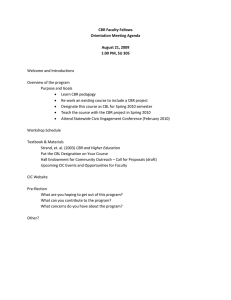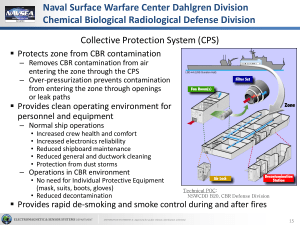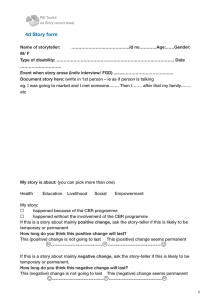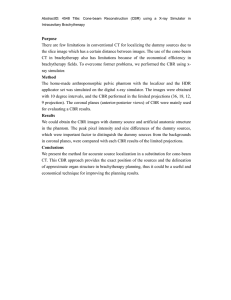CBR Prediction for Soil: Lab Tests & Flexible Pavement Design
advertisement
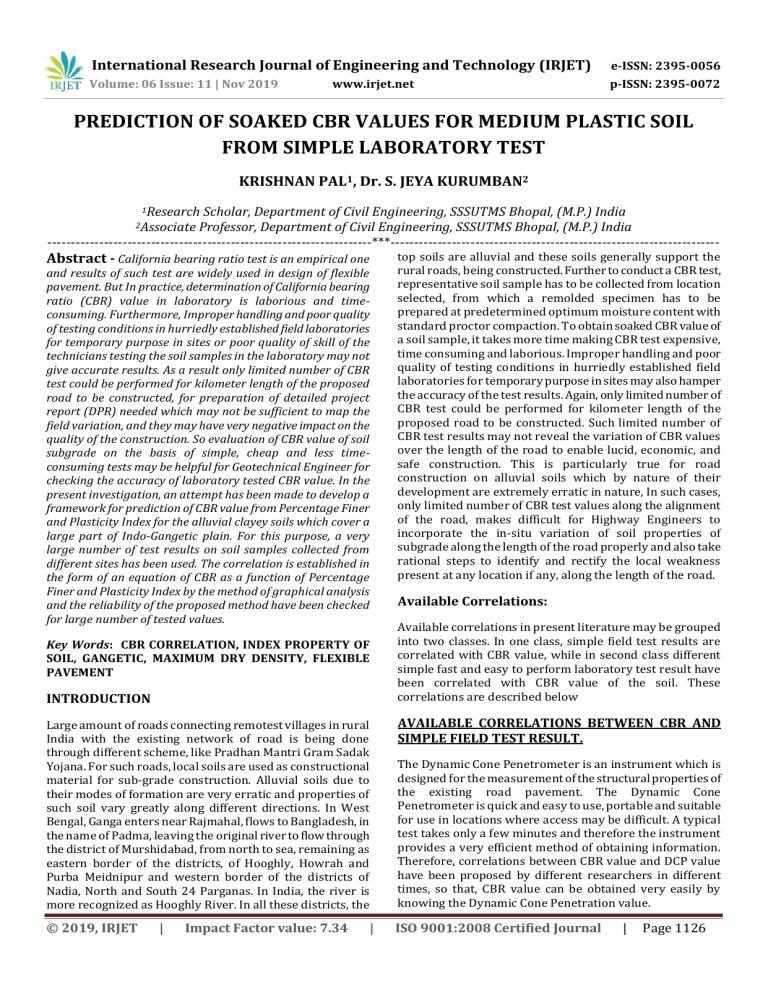
International Research Journal of Engineering and Technology (IRJET) e-ISSN: 2395-0056 Volume: 06 Issue: 11 | Nov 2019 p-ISSN: 2395-0072 www.irjet.net PREDICTION OF SOAKED CBR VALUES FOR MEDIUM PLASTIC SOIL FROM SIMPLE LABORATORY TEST KRISHNAN PAL1, Dr. S. JEYA KURUMBAN2 1Research Scholar, Department of Civil Engineering, SSSUTMS Bhopal, (M.P.) India Professor, Department of Civil Engineering, SSSUTMS Bhopal, (M.P.) India ---------------------------------------------------------------------***---------------------------------------------------------------------2Associate Abstract - California bearing ratio test is an empirical one and results of such test are widely used in design of flexible pavement. But In practice, determination of California bearing ratio (CBR) value in laboratory is laborious and timeconsuming. Furthermore, Improper handling and poor quality of testing conditions in hurriedly established field laboratories for temporary purpose in sites or poor quality of skill of the technicians testing the soil samples in the laboratory may not give accurate results. As a result only limited number of CBR test could be performed for kilometer length of the proposed road to be constructed, for preparation of detailed project report (DPR) needed which may not be sufficient to map the field variation, and they may have very negative impact on the quality of the construction. So evaluation of CBR value of soil subgrade on the basis of simple, cheap and less timeconsuming tests may be helpful for Geotechnical Engineer for checking the accuracy of laboratory tested CBR value. In the present investigation, an attempt has been made to develop a framework for prediction of CBR value from Percentage Finer and Plasticity Index for the alluvial clayey soils which cover a large part of Indo-Gangetic plain. For this purpose, a very large number of test results on soil samples collected from different sites has been used. The correlation is established in the form of an equation of CBR as a function of Percentage Finer and Plasticity Index by the method of graphical analysis and the reliability of the proposed method have been checked for large number of tested values. Key Words: CBR CORRELATION, INDEX PROPERTY OF SOIL, GANGETIC, MAXIMUM DRY DENSITY, FLEXIBLE PAVEMENT INTRODUCTION top soils are alluvial and these soils generally support the rural roads, being constructed. Further to conduct a CBR test, representative soil sample has to be collected from location selected, from which a remolded specimen has to be prepared at predetermined optimum moisture content with standard proctor compaction. To obtain soaked CBR value of a soil sample, it takes more time making CBR test expensive, time consuming and laborious. Improper handling and poor quality of testing conditions in hurriedly established field laboratories for temporary purpose in sites may also hamper the accuracy of the test results. Again, only limited number of CBR test could be performed for kilometer length of the proposed road to be constructed. Such limited number of CBR test results may not reveal the variation of CBR values over the length of the road to enable lucid, economic, and safe construction. This is particularly true for road construction on alluvial soils which by nature of their development are extremely erratic in nature, In such cases, only limited number of CBR test values along the alignment of the road, makes difficult for Highway Engineers to incorporate the in-situ variation of soil properties of subgrade along the length of the road properly and also take rational steps to identify and rectify the local weakness present at any location if any, along the length of the road. Available Correlations: Available correlations in present literature may be grouped into two classes. In one class, simple field test results are correlated with CBR value, while in second class different simple fast and easy to perform laboratory test result have been correlated with CBR value of the soil. These correlations are described below Large amount of roads connecting remotest villages in rural India with the existing network of road is being done through different scheme, like Pradhan Mantri Gram Sadak Yojana. For such roads, local soils are used as constructional material for sub-grade construction. Alluvial soils due to their modes of formation are very erratic and properties of such soil vary greatly along different directions. In West Bengal, Ganga enters near Rajmahal, flows to Bangladesh, in the name of Padma, leaving the original river to flow through the district of Murshidabad, from north to sea, remaining as eastern border of the districts, of Hooghly, Howrah and Purba Meidnipur and western border of the districts of Nadia, North and South 24 Parganas. In India, the river is more recognized as Hooghly River. In all these districts, the AVAILABLE CORRELATIONS BETWEEN CBR AND SIMPLE FIELD TEST RESULT. © 2019, IRJET ISO 9001:2008 Certified Journal | Impact Factor value: 7.34 | The Dynamic Cone Penetrometer is an instrument which is designed for the measurement of the structural properties of the existing road pavement. The Dynamic Cone Penetrometer is quick and easy to use, portable and suitable for use in locations where access may be difficult. A typical test takes only a few minutes and therefore the instrument provides a very efficient method of obtaining information. Therefore, correlations between CBR value and DCP value have been proposed by different researchers in different times, so that, CBR value can be obtained very easily by knowing the Dynamic Cone Penetration value. | Page 1126 International Research Journal of Engineering and Technology (IRJET) e-ISSN: 2395-0056 Volume: 06 Issue: 11 | Nov 2019 p-ISSN: 2395-0072 www.irjet.net A. In1975, Kleyn, proposed a correlation between CBR value and DCP value. He proposed: log(CBR) = 2.62 -1.27 log (DCP) B. In 1987, Livneh made his research on Granular and cohesive soil and proposed a correlation between CBR value and DCP value. He proposed: log(CBR) = 2.56 - 1.16 log (DCP) K. In 2010, Gupta, Kumar and Rastogi conducted experiment to find a correlation between CBR value and DCP value. There Field evaluation was carried out on thin bituminous surfaced granular pavements constructed under PMGSY programme in Uttar Pradesh and Uttarakhand states of India. They proposed CBR= 35.476(DCP)-1.28 C. In 1987, Harison also carried out his research on Granular and cohesive soil and proposed a correlation. He proposed: L.In 2012, Desalegn, made his research to find the correlation between Cone Penetrometer (DCP) with CBR values that best suit the type of soils in Ethiopia. Accordingly, several laboratory tests and field tests he proposed a correlation log (CBR) = 2.55 -1.14 log (DCP) log (CBR) = 2.954 – 1.496log (DCPI) D. In 1992, Livneh et al. made elaborate study on CBR on Granular and cohesive soil and proposed a correlation as below. The relation obtained from statistical analysis has an R 2 value of 0.943. log (CBR) = 2.45 -. 1.12 log (DCP) The results of the statistical analysis show that good correlation does exist between the dynamic cone penetration indexes (DCPI) and unsoaked CBR values. E. Later in 1992, Webster et al. carried out research on CBR on different types of soil and proposed that: log(CBR) = 2.46 - 1.12 log (DCP) F. In 1995, Ese et al. proposed an another correlation. They carried out detailed study on aggregate base course and proposed that: log(CBR) = 2.44 -1.07 log (DCP) Correlations with Clegg Impact Value (CIV). One simple device for the measurement of strength and stiffness of soil layers is the clegg Impact Tester. The Clegg Impact value(CIV) given by the machine is the resistance offered by the top soil of about 25 cm thickness against a falling hammer of standard weight. The Clegg Impact soil Tester is commonly used inBretain. G. In 1998, North Carolina Department of Transportation (NCDOT) proposed a correlation between CBR value and DCP value. They used aggregate base course and cohesive soils for their research .They suggested: Log(CBR) = 2.60 -1.07 log (DCP) H. In 1999, Coonsereported work on Piedmont residual soil and proposed that: Log(CBR) = 2.53 - 1.14 log (DCP) As the CIV too is a measure of soil strength, research works were carried out to examine the possibility of correlating the same with CBR values and these co relations are found. A. In 1995, Venkataraman et. al. developed an equation, besed on his experiments, conducted on soil mixtures with different combination of Sand and Gravel. CBR(%) = 1.3728(CIV) + 0.868 The above Equation has a correlation coefficient (r) = 0.9 I. Karunaprema and Edirisinghe (in 2002) investigated for similar relationship for Clayey gravel and silty gravel of SriLanka and proposed a correlation between Dynamic Cone Penetration (DCP)value and CBR value. They proposed: Log (CBRunsoaked) = 1.966 – 0.667LogDCP This equation shows a very good result for Laterite or Lateritic soil. B. Later, In2000, Kumar et. al. proposed an another co rrelation which shows a very good result for Alluvial Soil, B.C .Soil, Gravel, Moorum etc. He proposed: CBR = 0.0039[CIV]1.94 CBRunsoaked - CBRsoaked = 67.12 – 1.48W – 30.64DCP1/W J. In 2009, Sahooet. al. proposed a correlation between CBR value and DCP value. He proposed C. To find a better result for all types of soil, Omar et. al. proposed an another correlation in 2002. CBR = 0.169[CIV] + 1.695 CBR=67.687(DCP)-1.1029 © 2019, IRJET | Impact Factor value: 7.34 | ISO 9001:2008 Certified Journal | Page 1127 International Research Journal of Engineering and Technology (IRJET) e-ISSN: 2395-0056 Volume: 06 Issue: 11 | Nov 2019 p-ISSN: 2395-0072 www.irjet.net D. Later, in 2003, Chandrasekhar et. al. proposed an another correlation for Lateritic soil .They developed the equation based on his laboratory test result of soils which was collected from Tirupati Town. He proposed that: CBR(%) = 1.1242(CIV) – 0.3466 AVAILABLE CORRELATIONS BETWEEN CBR AND SIMPLE LABORATORY TESTS A. In 2008, Vinod and Cletus gives a correlation between CBR and Liquid Limit of soil .He had done a lot of experiment to develop the equation. He collected a large number of Lateritic soil sample from different part of South India(Thiruvananthapuram, Kollam etc). Then, CBR = 75/ [1+0.728(Ipw)] This equation is best suited for Lateritic soils or Laterite soils D.In 2004, Shukla and Kukalyekar proposed an another correlation to predict the CBR value from Optimum Moisture Content and Maximum Dry Density. They proposed that: CBR(SOAKED) = -2.97 – 0.1162 * OMC + 12.9853 * MDD CBR(UNSOAKED) = -5.71 – 0.2235 *OMC + 24.9717 *MDD E.In 2006, Kin proposed a correlation to predict soaked CBR values from Optimum Moisture Content (OMC) and Maximum Dry Density(MDD).He proposed: CBR = OMC*(MDD/19.3)20 He proposed that: F.In 2009, Roy et. el. Proposed an another correlation to predict the soaked CBR value from Optimum Moisture Content (OMC) and Maximum Dry Density(MDD).He proposed that : CBR = - 0.889 (WLM) + 45.616 Where, WLM = Modified Liquid Limit = LL (1 - C/100) Log[CBR]=Log[MDD/UNIT WEIGHT OF WATER] – Log[OMC] LL = Liquid Limit of soil passing 425 micron sieve (in percent). G. In 2010, FeredeProposed an another correlation to predict the soaked CBR value for Granular Soils .He proposed: C = fraction of soil coarser than 425 Micron sieve (in percent). CBR = - 27.998 +0.029 *OMC2 +4.796 *MDD4 B. In 2010, FeredeProposed a simple correlation to predict the soaked CBR value for Silty-Clay. He proposed: Ln CBR = 4.175 – 0.029*LL -0.009* P200 H. In 2010, Patel&Desai, proposed an another correlation to determine the value of soaked and unsoaked CBR for Fine Grained Soil. He proposed: CBRunsoaked= 17.009 - 0.0696PI - 0.296MDD + 0.0648OMC Where, P200=Percentage of soil particle which is passing 200micron Sieve CBRsoaked= 43.907-0.093PI - 18.78MDD - 0.3081OMC C.In 2001, Transportation Research Board recommend a co relation formulae to estimate the values of Plasticity Index. According to this formulae for materials with plasticity Index (Ip), greater than zero, a weighted plasticity index, termed Ipwis used where, weighted plasticity index = Ipw= Ip*P200 I. U.C.Saboo, M.G.Kalpana Rani and A.S.Bisbt (in2010), proposed an another correlation .They tested Thirty four different types of soil sample in the Laboratoy to evaluate different properties. Based on these results, they made a best possible correlation. They Proposed: CBR = 7.88*MDD – 0.17*P0.075 – 0.07*wLL + 5.07 Ip = Plasticity Index of soil in percent. Where, P200 = Percentage Passing 200 micron sieve. P0.075 = Percent Passing 75 micron IS sieve. Now, wLL = Weighted Liquid Limit = LL*(P425/100). when ,weighted plasticity index( Ipw) = 0 P0.425 = Percent Passing 425 micron IS sieve Then, CBR = 28.09(D60) 0.358 And, when soils exhibits some plasticity and containing more than 12 Percent fines(i.eIp is greater than zero) In 1970, Based on the research on 48 soil samples of fine grained soils found in India, Agarwal and Ghanekar had tried to develop a correlations between CBR values and either liquid limit, plastic limit or Plasticity index but could © 2019, IRJET ISO 9001:2008 Certified Journal | Impact Factor value: 7.34 | | Page 1128 International Research Journal of Engineering and Technology (IRJET) e-ISSN: 2395-0056 Volume: 06 Issue: 11 | Nov 2019 p-ISSN: 2395-0072 www.irjet.net not find any significant relationship between them. However ,they found a better correlation of CBR with optimum moisture content(Wopt) and liquid limit (LL).They suggested that: CBR = 2.0 – 16.0*log (Wopt) + 0.07*LL soil passing 75µ and PI is plasticity index of soil. From the relationship the trend of variation of CBR value with the change of (W*PI) value was noted. Now, efforts are made to establish a best fit curve that can fit the point as closely as possible. The equation of best fit curve is developed for necessary co relation. Need for further Study: Analysis of Alluvial soil: From the review of literature, it is observed that studies on the prediction of CBR value by correlating the CBR with easily determinable soil parameter have been made to some extent. Such correlation being empirical in nature, may give reliable results only for the region from which such soil data for correlation were collected. Further majority of correlation are for CBR in unsoaked condition while in design of flexible pavement, CBR value in soaked condition, are used. Here mainly Medium Plastic soils are analyzed and it is also divided into CL and CI Group to find the accurate result. From the chosen data (W*PI) values are plotted against CBR(soaked) value to develop a best fitted curve which is shown in figure Stressing on the need for alternate method for CBR test, Sikder (2003) indicated that possible variation in pavement thickness, resulting from an error in estimation of CBR value, may lead to unnecessary wastage of capital investment. Similarly the non-identification of the weak sport along the alignment of proposed road which is possible when only limited number of CBR test are conducted in conventional manner, may lead to short life of the road. W Reliability of any prediction depends primarily on the relative importance of the factor in controlling the magnitude of the output. In search of the best correlation for CBR, the most important parameter influencing the value of CBR should be identified. This was studied by Kaur et el (2011), following innovative technique proposed by Garson (1991). They have indicated that PI followed by LL are the most important factor influencing the value of CBR, other parameter like maximum dry density, fine fraction, sand fraction etc, have influence but of much lesser significance In view of the above discussion, a study was undertaken for finding the correlation between soaked CBR value and PI and Percentage Finer of the soils from alluvial plain and validity of the correlation developed is tested by comparing the predicted value of CBR(soaked) into tested value of CBR(Soaked). Development of Relationship CBR(Soaked) and Index Properties. Between To develop the relationship a large number of test results on fine-grained soil samples are collected from different sites in West Bengal. . All the data are divided into two parts, one part is used to develop the prediction model and another part is used to check the validity of the proposed correlations. Here the test results of High Plastic soil(PI value is between 7 to 17) are used. For each group of soils the observed values of CBR are plotted against (W*PI) of the soil. Where W is percentage of © 2019, IRJET | Impact Factor value: 7.34 | Table 1: Test results of the soil sample collected to develop the correlation PI LL W*PI MEASURED CBR GROUP 83.4 10.1 21.6 843.16 5.36 CL 87.6 9.56 21.7 837.27 5.49 CL 67 11.6 22.3 775.2 6.1 CL 59.6 10.9 27.2 648.42 6.9 CL 60.4 11.2 27.9 675.4 6.8 CL 62.5 11.8 28.8 736.6 6.5 CL 73.7 11.1 30 821.7 5.6 CL 65 16.1 30 1049.4 4.6 CL 87 13.1 30 1144 4 CL 77 15.2 30 1170 4 CL 58.2 14.3 30.2 834.72 5.6 CL 53.8 12.2 31 657.6 7.25 CL 89 13.1 31 1170 4 CL 89 13.1 31 1170 3.91 CL 73 16.2 31 1184 4.05 CL 87.44 15 31 1308 3.55 CL 97 15.2 31.21 1476.9 3.24 CL 84 14.2 32 1190 4 CL 88 14.2 32 1246 3.64 CL 88 13.8 32.6 1210.4 3.8 CL 86.8 14.1 32.6 1220.4 3.66 CL 89 13.1 33 1170 4 CL 87.6 14.4 33 1258.1 3.57 CL 90 12.4 33.3 1119.3 4 CL 89 14.4 33.4 1278 3.57 CL 87.9 14.6 33.8 1280.2 3.71 CL ISO 9001:2008 Certified Journal | Page 1129 International Research Journal of Engineering and Technology (IRJET) e-ISSN: 2395-0056 Volume: 06 Issue: 11 | Nov 2019 p-ISSN: 2395-0072 www.irjet.net 91.6 14.4 33.9 1314.9 3.6 CL 84.6 9.39 22.3 5.49 5.9 7.42 CL 91 13.1 34 1196 4 CL 71 10.6 23.2 5.7 6.23 9.21 CL 70 17.2 34 1207 4 CL 71 11 23.4 5.7 6 5.24 CL 89.1 14.7 34 1306.5 3.5 CL 64 11.4 24.3 6.02 6.42 6.67 CL 93 12.8 34.2 1193.8 3.91 CL 62 16.8 28 4.8 4.5 -6.3 CL 89.1 15.1 34.4 1342.5 3.46 CL 59.4 13 28 6.28 6.07 -3.4 CL 65.5 16.8 34.5 1097.3 4.4 CL 80.5 11.9 28.5 5.2 4.89 -5.9 CL 89.5 15 34.5 1339.4 3.44 CL 88 11.5 28.8 5.1 4.63 -9.2 CL 88.8 15.1 34.6 1338 3.43 CL 87.6 11.5 29 5.1 4.65 -8.8 CL 92 13.1 35 1209 4 CL 66.5 14.1 29.6 5.3 5 -5.7 CL 87 17.2 35 1496 3 CL 61.5 14 30 5.95 5.44 -8.5 CL 80 16 30 4 3.66 -8.5 CL From the chosen data(W*PI) values are plotted against CBR(soaked) value to develop a best fitted curve which is shown in figure. 85 13 30 4.57 4.24 -7.2 CL 81 15 30 4 3.86 -3.6 CL 81 15 30 4 3.86 -3.6 CL Now, from the plotted points the best fit curve is found. And the equation of the best fit curve is calculated. The equation of the best fit curve is CBR(soaked)=4683/(W*PI) 90 12 30 4.08 4.34 6.32 CL 85 12 30 4.18 4.59 9.88 CL 89.7 9 13.4 8 30.7 3.62 3.87 6.93 CL 89 13 31 3.79 4.05 6.84 CL 72 11 31 5.5 5.92 7.55 CL 73 15.3 31.8 4.49 4.19 -6.6 CL 80 16 32 4 3.66 -8.5 CL 91 14 32 4 3.68 -8.1 CL 91 14 32 4 3.68 -8.1 CL 90 14 32 4.01 3.72 -7.3 CL 90 14 32 4 3.72 -7 CL 90 14 32 4 3.72 -7 CL VALIDATION OF CORRELATIONS: 74 16.3 32 4.1 3.88 -5.3 CL Validity of the correlation developed was tested by comparing the predicted value of CBR (soaked) with tested value of CBR (soaked) on alluvial soil deposits, which are reproduced in Table 2. 64 11.4 24.3 6.02 6.42 6.67 CL 74 15 32 4 4.22 5.52 CL 90 13 32 3.79 4 5.65 CL 89 13 32 3.8 4.05 6.56 CL Table 2: Tested value of CBR (soaked) with Predicted values 72 15 32 4 4.34 8.45 CL 100 11.6 32.1 4.3 4.04 -6.1 CL 88.4 14 32.2 4.2 3.79 -9.9 CL 86.5 14.3 32.2 4.17 3.79 -9.2 CL W PI M.CB R LL P. CBR ERRO R GROU P 67 10.6 20.1 6.1 6.6 8.14 CL 100 14 33 3.69 3.35 -9.3 CL 87.2 9.97 21.2 4.96 5.39 8.65 CL 88.7 14 33.1 3.52 3.77 7.18 CL 88.8 9.23 22 5.23 5.72 9.29 CL 94 13.4 33.2 4.05 3.72 -8.2 CL © 2019, IRJET | Impact Factor value: 7.34 | ISO 9001:2008 Certified Journal | Page 1130 International Research Journal of Engineering and Technology (IRJET) e-ISSN: 2395-0056 Volume: 06 Issue: 11 | Nov 2019 p-ISSN: 2395-0072 www.irjet.net 88.7 14.1 33.2 3.57 3.75 4.93 CL 90.4 16.4 33.3 3.49 3.16 -9.5 CL 88 16.5 33.4 3.56 3.23 -9.4 CL 100 12.1 33.5 4.05 3.87 -4.4 CL 100 14.3 33.7 3.52 3.28 -6.9 CL 91 14 34 4 3.68 -8.1 CL 71.4 16.1 34 4.3 4.08 -5.2 CL 93 13 34 4.01 3.88 -3.4 CL 90 16.4 34.1 3.5 3.17 -9.3 CL 88 14.5 34.3 3.5 3.67 4.9 CL 88.4 16.3 34.4 3.5 3.25 -7.1 CL 90.2 12.7 34.5 4.3 4.09 -4.9 CL 79 14 34.5 3.94 4.24 7.51 CL 90.1 13.1 34.6 4.1 3.97 -3.2 CL 90.4 13.5 34.8 4.2 3.84 -8.6 CL 81 16 35 4 3.61 -9.6 CL 90 14 35 4 3.72 -7 CL 78 16 35 4 3.75 -6.1 CL 78 16 35 4 3.75 -6.1 CL 78 16 35 4 3.75 -6.1 CL 89 14 35 4 3.76 -6 CL 100.5 10.75 1080 89 14 35 4 3.76 -6 CL 99.5 13.57 89 14 35 4 3.76 -6 CL 92.5 85 13 35 4 4.24 6 CL 92 12 35 4 4.24 6.09 CL 89 12 35 4 4.39 9.67 CL Fig: Measured and Predicted Soaked CBR Values are plotted. Analysis for CI Group Soil: Table 2: Test results of the soil sample collected to develop the correlation Note: M.CBR and P.CBR represents Measured and Predicted Soaked CBR Value. Further the plotting of measured and predicted values of CBR (Soaked) are also given in figure for comparison. It may be observed from the fig., that the predicted soaked CBR values are quite close to the measured values using the present correlation for majority of test results. © 2019, IRJET | Impact Factor value: 7.34 PI M. CBR GROUP 35.3 4.34 CI 1350 35.8 3.39 CI 13.92 1288 36 3.64 CI 84.4 14.31 1208.2 39.6 3.83 CI 85.5 14.32 1224 39.6 3.77 CI 100.5 14.53 1460 40.4 3.29 CI 85.8 14.61 1253.9 40 3.72 CI 79.5 14.91 1185 37 4 CI 94.5 14.92 1410 36 3.43 CI 100.5 15.12 1520 40.9 3.11 CI 86.6 15.21 1317.3 40.7 3.66 CI 98 15.31 1500 42.6 3.01 CI 100.5 15.32 1540 38.6 3.07 CI 87.2 15.61 1361.2 41 3.31 CI 100.5 15.62 1570 40.2 2.91 CI 100.5 15.72 1580 50 3.04 CI 99.5 15.78 1570 42.3 2.89 CI 99 15.82 1566.2 43.2 2.89 CI 76.5 15.9 1216 36 4 CI 76.5 15.9 1216 36 4 CI W | w*PI LL ISO 9001:2008 Certified Journal | Page 1131 International Research Journal of Engineering and Technology (IRJET) e-ISSN: 2395-0056 Volume: 06 Issue: 11 | Nov 2019 p-ISSN: 2395-0072 www.irjet.net 82.6 15.9 1313.6 42 3.5 CI 96 15.1 35.7 3.01 3.24 7.72 CI 92.4 15.91 1470.4 40 3.1 CI 90 14 36 4 3.73 -6.75 CI 100.5 15.92 1600 37.4 2.97 CI 92 13.4 36.1 4.18 3.81 -8.79 CI 99 15.96 1580 50 2.87 CI 100 15.9 36.3 3.08 2.96 -4.03 CI 87.9 16.11 1415.9 41.5 3.42 CI 83 15.6 36.5 3.94 3.63 -7.87 CI 88.8 16.51 1465.8 42 3.29 CI 72.2 16.58 1197.4 39.2 3.82 CI 83 15.6 36.5 3.94 3.63 -7.87 CI 85.9 16.7 1434.7 42.2 3.26 CI 92 15 37 3.64 3.41 -6.43 CI 71.5 16.88 1207 36 4 CI 69.1 15.9 38.1 4.03 4.28 6.15 CI 100 16 38.5 3.26 2.94 -9.89 CI From the chosen data,(W*PI) values are plotted against CBR(soaked) value to develop a best fitted curve which is shown in figure. 70.7 16.9 38.5 4.13 3.93 -4.76 CI 100 15.7 38.6 3.25 2.99 -7.89 CI 94.9 15.4 38.6 3.07 3.22 4.75 CI The equation of the best fit curve is: 74.8 16.9 38.8 3.48 3.72 6.84 CI CBR(soaked )= 4705/(W*PI) 69.4 16 39 4 4.23 5.82 CI 74.1 16.9 39.5 3.49 3.75 7.54 CI 74.1 16.9 39.5 3.49 3.75 7.54 CI 100 14.3 39.6 3.08 3.29 6.71 CI 96.3 13.6 39.7 3.29 3.59 9.08 CI 76.6 15.9 39.9 3.68 3.86 4.86 CI 71.3 16.8 39.9 3.69 3.92 6.33 CI 100 16.8 40.1 3.02 2.8 -7.36 CI 100 15.4 40.2 3.21 3.05 -4.92 CI 72.2 16.9 40.5 3.64 3.85 5.82 CI 73.4 17 40.6 3.55 3.77 6.1 CI 92.7 17 41 3.3 2.98 -9.62 CI 87.2 15.9 41.2 3.66 3.39 -7.38 CI 87.1 15.8 41.2 3.68 3.42 -7.19 CI 100 13.6 41.3 3.25 3.46 6.33 CI 87.3 16.3 41.6 3.63 3.3 -9.01 CI 87.7 16.4 41.8 3.62 3.27 -9.73 CI 87.9 16.5 41.9 3.6 3.24 -9.98 CI 87.9 16 41.9 3.63 3.34 -7.94 CI 82.1 16 42 3.9 3.58 -8.26 CI 93.2 17 42 3.2 2.97 -7.3 CI 88.7 17 42.4 3.25 3.12 -4.09 CI VALIDATION OF CORRELATIONS: Validity of the correlation developed was tested by comparing the predicted value of CBR (soaked) with tested value of CBR (soaked) on alluvial soil deposits in different districts of West Bengal as reported for PMGSY roads, which are reproduced in Table 3. Table 3: Tested value of CBR (soaked) with Predicted values W PI LL M .CBR P. CBR ERROR GROUP 76.4 16.3 35.3 4.2 3.77 -10.1 CI 100 15.3 42.7 2.81 3.07 9.32 CI 100 10.8 35.3 4.14 4.35 5.12 CI 100 13 35.3 3.43 3.62 5.4 CI 100 100 100 14 15.4 17 43.8 43.9 47.8 3.11 2.91 3.01 3.36 3.05 2.76 7.95 4.88 -8.15 CI CI CI © 2019, IRJET | Impact Factor value: 7.34 | ISO 9001:2008 Certified Journal | Page 1132 International Research Journal of Engineering and Technology (IRJET) e-ISSN: 2395-0056 Volume: 06 Issue: 11 | Nov 2019 p-ISSN: 2395-0072 www.irjet.net Further the plotting of measured and predicted values of CBR (Soaked) are also given in figure for comparison. It may be observed from the fig., that the predicted soaked CBR values are quite close to the measured values using the present correlation for majority of test results REFERENCES 1. Agarwal, K.B. & Ghanekar, K.D. (1970): Prediction of CBR from Plasticity Characteristics of Soil. Proceeding of 2nd South-east Asian Conference on Soil Engineering, Singapore. June 11-15, Bangkok: Asian Institute of Technology, 571576. 2. Black, W.P.M. (1962): A Method of Estimating the CBR of Cohesive Soils from Plasticity Data. Geotechnique. Vol.12, 271 - 272. 3. Central Road Research Institute (1990), “Document on Rural Road Development in India”, Vol. II, CRRI, New Delhi. 4. Chattopadhyay BC and Maity J,(2012) “Prediction Of CBR Of Different Groups Of Alluvial Soils For Design Of Flexible Pavements”, International Symposium On Engineering Under Uncertainty: Safety Assessment And Management, January 4 To 6,2012.Paper No. CNP 028 5. Kin MW (2006) California bearing ratio correlation with soil index properties. Master’s thesis, Faculty of Civil Engineering, University of Technology, Malaysia CONCLUSIONS: On the basis of test results for CBR (Soaked) value of various Alluvial soil, a generalized correlation between soaked CBR value and Percentage Finer (75 micron) and Plasticity Index of Alluvial soils have been established 1) New correlations have been proposed for predicting the CBR value from Percentage Finer (75 micron) and Plasticity Index. CBR(soaked)= X/(W*PI) ……….(6.1) PI = Plasticity Index The different values of X for different types of soil are given below Table: value of X SOIL TYPE PLASTICITY RANGE GROUP VALUE OF X MEDIUM PLASTIC 7-17 CL 4683 7-17 CI 4705 Impact Factor value: 7.34 9. Srinivasa Rao, K.(2004).Correlation between CBR and Group Index .Proceedings of the Indian Geotechnical Conference.Warangal, 477-480 10. Sikdar, P.K. (2003),”Pradhan Mantri Gram Sadak Yojan, striving for Quality and Economy”, Indian Highways, IRC, New Delhi, vol 31, No 6, pp 77-91 11. Shukla, S.K. and Kukalyekar, M.P(2004),”Development of CBR Correlations for the Compacted Fly Ash.”Proceedings of the Indian Geotechnical Conference Wanrangal, pp. 53-56 2) When experimental values of CBR (soaked) are compared with predicted value of CBR(soaked) with large number of data, the predicted value of CBR on the basis of presented correlation gives very excellent results and the variation between predicted and observed values are generally below 10%. | 7. National Cooperative Highway Research Program (2002), “Guide for mechanistic and empirical – design for new and rehabilitated pavement structures, Final document. In: Appendix CC-1: Correlation of CBR values with Soil Index Properties”, West University Avenue Champaign, Illinois, USA. 8. Patel, S.R. and Desai, M.D. 2010. CBR Predicted by Index Properties for Alluvial Soils of South Gujarat, Dec. 16-18, 7982, Proceedings of Indian GeotechnicalConference–2010, India. Where, W= Percentage Finer through 75 micron © 2019, IRJET 6.Kaur,S.,Ubboveja,and Agarwal, A.(2011), “Artificial Neural Network Modulling For Prediction Of CBR, ”Indian Highways,Vol39,No1,pp31-38 | 12. Sahoo, U. C. and Reddy, K. S. (2009). Subgrade strength characterization for low volume roads in India, Proc., of International Conference on Pavement Engineering, ICPE2009, College of Engineering and Technology, B.P.U.T. Bhubaneswar, 86-93. ISO 9001:2008 Certified Journal | Page 1133
